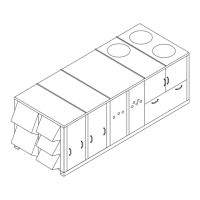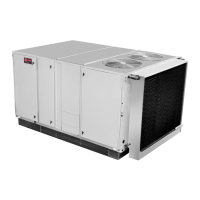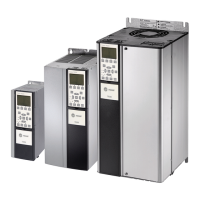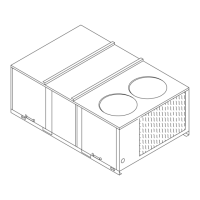136 RT-SVX34C-EN
Diagnostics
6 Flashes: OA Humidity Sensor out of range
7 Flashes: OA Temp Sensor out of range
8 Flashes: MA Temp Sensor out of range
9-11 Flashes: Internal ECA failure
Note: The Outdoor Air Sensor (OAS) is also used for the economizer operation. It is connected to
the RTRM.
Test 1
Voltage
Disconnect the OAS from the wires in the return air section. Check the voltage at the wires going
to the RTRM. The voltage should be 5 (± 0.25) VDC.
Check the resistance at the wires going to the OAS and measure the temperature at the OAS
location. Using the Temperature versus Resistance chart, verify the accuracy of the OAS.
If voltage specified is not present, the ECA has failed.
Test 2
Testing the ECA sensors.
1. Testing the Mixed Air Sensor (MAS). Disconnect the cable connected to MAT on the ECA.
a. Measure the resistance of the sensor between the connector terminals P23-1 and P23-2.
b. Measure the temperature at the MAS location. Using the Temperature versus Resistance
chart, verify the accuracy using the Thermistor Resistance/Temperatue Chart Table 15 on
page 52.
Replace the sensor if it is out of range.
2. Testing the Return Air Sensor (RAS). Disconnect the cable connected to RAT on the ECA. Using
the Thermistor Resistance / Temperature Chart
Tab le 15 on page 52.
a. Measure the resistance of the sensor between the connector terminals P10-1 and P10-2.
b. Measure the temperature at the RAS location. Using the Temperature versus Resistance
chart, verify the accuracy of the RAS.
Replace the sensor if it is out of range.
3. Testing the Humidity Sensors.
a. Return Humidity Sensor (RHS). Leave the sensor connected to the ECA, and measure the
operating current. The normal current range is 4 to 20 mA (milliampere). Replace the sensor
if it is out of range.
b. Outdoor Humidity Sensor (OHS). Leave the sensor connected to the ECA, and measure the
operating current. The normal current range is 4 to 20 mA (milliampere). Replace the sensor
if it is out of range.
Note: Both the RHS and the OHS are polarity sensitive. Verify that the polarity is correct before
condemning the sensor. Incorrect wiring will not damage any of the controls, but they will
not function if wired incorrectly.
ReliaTel Air Module (RTAM) Test
Test 1
Testing the Inlet Guide Vane/Variable Frequency Drive (IGV/VFD) Output.
1. Using the "Test Mode" procedure for VAV applications in the "Unit Startup" section, step the unit
to the first test (Step 1). Verify that 8.5 VDC is present between terminals J4-2 and J4-1 for IGV’s
or 10 VDC for VFD’s.

